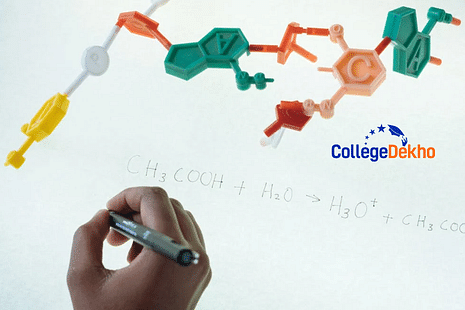
WBJEE 2025 Organic Chemistry Practice Questions:
Organic Chemistry for WBJEE 2025 covers topics such as Carbon, Bonding, Alkanes, and Haloalkanes. It carries a weightage of approximately 6% and a good 4-5 questions are asked every year from this chapter. Organic Chemistry is one of the most important chapters in the WBJEE Chemistry syllabus 2025. To be able to attempt the maximum number of questions and score high marks in the examination, you should diligently solve WBJEE 2025 Organic Chemistry practice questions from these topics. WBJEE Organic Chemistry sample questions are meant to provide you with a series of probable questions that may be asked in the upcoming
WBJEE 2025 exam
. Our experts have prepared a set of model questions based on the previous years' question papers and topic weightage. You can find the WBJEE 2025 Organic Chemistry practice questions with solutions on this page.
Also Check -
WBJEE 2025 Vector Algebra Practice Questions with Solutions
Quick Links:
| WBJEE 2025 Exam Pattern | WBJEE 2025 Exam Date |
|---|
List of WBJEE 2025 Organic Chemistry Sub Topics for Exam Preparations
The WBJEE 2025 Chemistry syllabus PDF highlighting the key topics from the Organic Chemistry section is available on the official WBJEE website. The sub-topics contain detailed description, theories and formulae from the Organic Chemistry chapter. It is important to prepare all the sub-topics from Organic Chemistry in order to have a dedicated study plan. Check out the list of Organic Chemistry topics for WBJEE 2025.
Chapter | Sub Topics |
|---|---|
Organic Chemistry | Carbon |
Oxygen and Sulphur | |
Halogens | |
Polymers | |
Hybridization of carbon | |
Conformations of ethane and n-butane | |
Alkanes | |
Alkenes and Alkynes | |
Oxymercuration-demarcation | |
Haloalkanes and Haloarenes | |
Alcohols | |
Ethers | |
Amines |
Quick Links:
| Best WBJEE Coaching Institutes in India 2025 | WBJEE Previous Year Question Papers |
|---|---|
| WBJEE Sample Papers | Best Books for WBJEE 2025 Exam Preparation |
WBJEE 2025 Organic Chemistry Expected Weightage
The expected marks weightage for WBJEE Organic Chemistry gives you an idea about how many marks the chapter will cover and how many questions may be asked from this section. The Organic Chemistry section includes 4-5 questions and has a weightage of around 6% making it an important part of the WBJEE 2025 syllabus PDF . Let’s have a look at the WBJEE 2025 Organic Chemistry expected marks weightage from the table below.
Topic | Expected Number of Questions | Expected Weightage |
|---|---|---|
Organic Chemistry | 4-5 | 6% |
WBJEE 2025 Organic Chemistry Practice Questions with Solutions
Good exam preparation includes solving WBJEE 2025 Organic Chemistry practice questions. This practice not only helps in building clarity on the Chemistry fundamentals but also gives enough material to practice for the examination. The following are some of the most important WBJEE 2025 Organic Chemistry practice questions with solutions.
Q1. In the IUPAC system, PhCH 2 CH 2 CO 2 H is named as:a. 3-phenylpropanoic acid
b. Benzylacetic acid
c. Carboxyethylbenzene
d. 2-Phenylpropanioc acid
Ans. a. 3-phenylpropanoic acidQ2. The correct acidity order of phenol (I), 4-hydroxybenzaldehyde (II) and 3-hydroxybenzaldehyde (III) is:
a. I < II < III
b. I < III <II
c. II < III < I
d. III < II < I
Ans. b. I < III <IISolution:
To determine the correct acidity order of phenol (I), 4-hydroxybenzaldehyde (II), and 3-hydroxybenzaldehyde (III), we need to consider the electron-withdrawing or electron-donating effects of the substituents on the phenol ring and how these affect the stability of the phenoxide ion after deprotonation.
The presence of the electron-withdrawing aldehyde group influences the acidity of the phenol by stabilizing the negative charge on the oxygen atom of the phenoxide ion. This stabilization is more significant when the aldehyde group is closer (para position) or less steric hindered compared to the hydroxyl group.
1. Phenol (I): Has no additional electron-withdrawing groups to stabilize the phenoxide ion, thus has the least acidity.
4-Hydroxybenzaldehyde (II): The CHO group at the para position significantly withdraws electron density through both inductive and resonance effects, stabilizing the phenoxide ion more effectively than at the meta position.
3-Hydroxybenzaldehyde (III): The CHO group at the meta position primarily withdraws electron density through inductive effects, which is less stabilizing than the para position incorporation.
Therefore, the correct acidity order is:
Phenol (I) < 3-Hydroxybenzaldehyde (III) < 4-Hydroxybenzaldehyde (II)
Or, I < III < II
Q3. Select the molecule in which all the atoms may lie on a single plane is:a. 4-Nitrobenzaldehyde
b. 4-Methoxybenzaldehyde
c. 4-Methylnitrobenzene
d. 4-Nitroacetophenone
Ans. a. 4-NitrobenzaldehydeQ4. The maximum number of atoms that can be in one plane in the molecule p-nitrobenzonitrile are:
a. 6
b. 12
c. 13
d. 15
Ans. d. 15Q5. Which structure has delocalized ⲡ-electrons?
a. O3
b. CO
c. HCN
d.O3 and HCN
Ans. a. O 3Q6. Among Me 3 N, C 5 H 5 N, and MeCN (Me = methyl group) the electronegativity of N is in the order:
a. MeCN > C5H5N > Me3N
b. C5H5N > Me3N > MeCN
c. MeN > MeCN > C5H5N
d. Electronegativity same in all
Ans. a. MeCN > C 5 H 5 N > Me 3 NQ7. The correct order of acid strengths of benzoic acid (X), peroxybenzoic acid (Y), and p-nitrobenzoic acid (Z) is:
a. Y > Z > X
b. Z > Y > X
c. Z > X > Y
d. Y > X > Z
Ans. c. Z > X > YQ8. How many monobriminated product(s) (including stereoisomers) would form in the free radical bromination of n-butane?
a. 2
b. 1
c. 3
d. 4
Ans. c. 3Q9. Which of the following statements about the SN 2 reaction mechanism is/are true?
a. The rate of reaction increases with increasing nucleophilicity
b. The number 2 denotes a second order reaction
c. Tertiary butyl substrates do not follow this mechanism
d. The optical rotation of substrates always changes from (+) to (-) or from (-) to (+) in the product
Ans. Options a., b., and c.Solution:
The correct statements about the SN 2 reaction mechanism are:
Option A: The rate of reaction increases with increasing nucleophilicity.
This statement is true. In an SN 2 reaction, the nucleophile attacks the electrophilic carbon in a single, concerted step. Therefore, a stronger (more nucleophilic) nucleophile will generally result in a faster reaction because it can more readily attack the carbon center.
Option B: The number 2 denotes a second-order reaction.
This statement is also true. The term SN 2 stands for bimolecular nucleophilic substitution and indicates that the rate-determining step involves two reacting species: the nucleophile and the electrophilic substrate. The rate law for an SN 2 reaction is given by:
Rate = k[Nucleophile][Electrophile]
This indicates that the reaction is second-order overall.
Option C: Tertiary butyl substrates do not follow this mechanism.
This statement is true. Tertiary butyl substrates are typically very sterically hindered, making it difficult for the nucleophile to approach the electrophilic carbon from the backside, which is required for the SN 2 mechanism. As a result, tertiary substrates usually do not undergo SN2 reactions.
Option D: The optical rotation of substrates always changes from (+) to (-) or from (-) to (+) in the products.
This statement is incorrect because in an SN 2 reaction inversion does take place but we can never say a dextro substrate will produce a levo product or vice-versa. Because the dextro or levo nature of the reactant or product is purely experimental.
Q10. Cyclopentanol on reaction with NaH followed by CS 2 and CH 3 I produces a/an:a. ketone
b. alkene
c. ether
d. Xanthate
Ans. d. XanthateQuick Links:
| WBJEE 2023 Question Paper PDF | WBJEE 2022 Question Paper PDF | WBJEE 2021 Question Paper PDF |
|---|
Related Articles
We hope that this post on the WBJEE 2025 Organic Chemistry Practice Questions with Solutions was helpful and informative. For the latest exam updates, stay tuned to CollegeDekho!
Are you feeling lost and unsure about what career path to take after completing 12th standard?
Say goodbye to confusion and hello to a bright future!

FAQs
Yes, Halogens are an important topic in Organic Chemistry for the WBJEE 2025 exam, the topic is part of the Organic Chemistry chapter.
The organic chemistry section includes questions based on IUPAC nomenclature, compound bonding, and properties of organic compounds.
The WBJEE 2025 Organic Chemistry practice questions with solutions are available online, check the article above to get WBJEE 2025 organic chemistry practice questions.
The percentage weightage of organic chemistry in the WBJEE 2025 exam is around 6%.
The Organic Chemistry section in the WBJEE 2025 has a weightage of around 6% and thus can feature 4-5 questions.
Yes, organic chemistry is one of the most important sections in the WBJEE chemistry syllabus, covering various important fundamentals.
Was this article helpful?





















Similar Articles
GATE CS Question Paper Difficulty Level Trends: A detailed analysis
JEE Main 2026 Chemistry High Priority and Low Priority Chapters
Are JEE Main Study Groups Worth It? Detailed Pros and Cons for 2026 Aspirants
How to Prioritize Physics Chapters Based on JEE Main 2026 Weightage and Difficulty
GATE 2026 Mechanical Engineering Expected No. of Questions Topic-Wise
GATE 2026 Civil Engineering Expected No. of Questions Topic-Wise